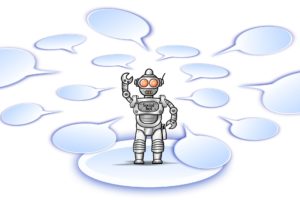Communication technology is progressing very fast. And today, most people prefer to connect through either text messages or messaging applications. To make life more convenient, organizations and industries are advancing communications by developing and investing in chatbots.

Chatbots are computer-programmed services that can interact like humans through a chat interface, both textually and auditorily. Also known as talkbots, smartbots, bots, chatterbots, or interactive agents, these programs are intended to communicate with the user and behave as if a real human is behind the conversation.
Presently, these bots are found in major chat or messaging solutions like Facebook Messenger, Kik, Slack, WeChat, Line, LiveChat, and Telegram. Given the technology’s ubiquity, even those who barely pay attention to modern technology have probably interacted with these bots several times already.
Two Kinds of Chatbots
Chatbots are not new. However, utilization of the bots has attracted industries in the last few years. First established in the 1960s, chatbots have come a long way from its initial development. There are two types of chatbots. The most common kind of chatbot is rule-based, and the more advanced one is powered with artificial intelligence.
Artificial intelligence (AI) chatbots use natural language processing systems. In this system, computers are programmed to read, process, and analyze large quantities of natural language data. Artificial intelligence technologies also include deep learning and machine-learning algorithms. AI bots learn from the conversations and interactions they had with people, expanding their database.
On the other hand, rule-based bots are made of simple systems and, therefore, have limited responses. The system scans and determines keywords form the user input and replies with the corresponding command. Unlike the AI-based chatbots, rule-based chatbots no longer respond when they encounter unfamiliar commands and unrecognized words.
Creation of a Technology
The creation of chatbots is similar to the pattern of developing mobile applications and web pages and initially starts with the design. This design describes the interaction of the bot and the user. The pattern also includes the building of the bot that involves the input analysis using a natural language processing engine. After the initial stages, analytics and maintenance of the bots are then done.
Chatbot development can be done on platforms offered by Platform-as-a-Service providers. Among these are the IBM Watson, SnatchBot, and Oracle Cloud Platform.
Recent studies seem to show that people spend more time using messaging applications than social media. Hence, messaging applications now provide more platforms for companies and businesses to reach a majority of consumers. The efficiency of chatbots, especially those that make use of AI, entices and encourages companies to invest in these types of services.
Use in Various Industries
Chatbots have a wide array of uses in different areas such as business, education, information, and entertainment. First used in online interactive games and instant messaging, these bots are now being classified based on their usage in communication, analytics, design, travel, sports, shopping, personal, food, and health.
In the business sector, many companies are already utilizing chatbots to improve their services and increase their sales. From the processing of online orders to marketing and customer service and support, the bots assist and cater to the need of the consumers any time of the day, with or without live agents. Airlines and e-commerce companies have also employed chatbots on their websites to provide information and answer inquiries to their clients and customers.
Some companies have also been investing in chatbots for internal affairs, such as in human resources. The bots can assist in processing and securing documents. Banking industries are likewise investing in chatbots in place of call center agents to accommodate their clients. Moreover, toy corporations are employing chatbot-based toys. These allow children to better interact with the toys, enabling them to learn better.
Generally, the use of chatbots in industries generates greater revenue while saving time and money. They also guide the consumers in finding what they are interested in, giving them a better and unique experience.
The Advent of Virtual Assistants
Chatbots also function as virtual assistants. Some of these bots are famous—you have probably heard of Amazon Alexa, Google Assistant, and Siri of Apple. These virtual assistants can do both simple and basic tasks, allowing consumers to focus on more important things.
These virtual assistant bots help people in a lot of ways. They keep their users informed with the current news and weather updates. They remind them of their schedules and assist them in their groceries and finances. More importantly, bots also act as a friend and confidante. In Asia, there is a country with a bot to whom millions of people speak to. Thus, it is safe to say that there are boundless possibilities with bots.

Into the Human Component
The evolution of technology and the development of chatbots definitely changed and improved the way people communicate. It serves as a bridge between businesses and consumers, helping them complete their tasks and achieve their goals regardless of where they may be.
Chatbots, at the end of the day, are programmed with codes and commands—made by people. The technology is not perfect as it is still progressing and is, therefore, prone to errors. Also, malicious use of chatbots in advertisements and spams have been reported to entice people and acquire personal information.
Bots and other artificial intelligence technologies are still monitored and maintained by humans. In transacting with bots, consumers are advised to be careful and protect their security and privacy at all times.
The evolution of technology has led to the development of artificial intelligence and chatbots, opening significant opportunities for businesses and companies while offering convenience to consumers at the same time. However, as to be expected, there are those who claim that it limits actual human social interactions.
Well, despite the convenience it brings, interacting with bots and other similar technologies don’t replace (or harm) human interaction. After all, the success of technology relies on the very people who use it—and those who are behind it.




